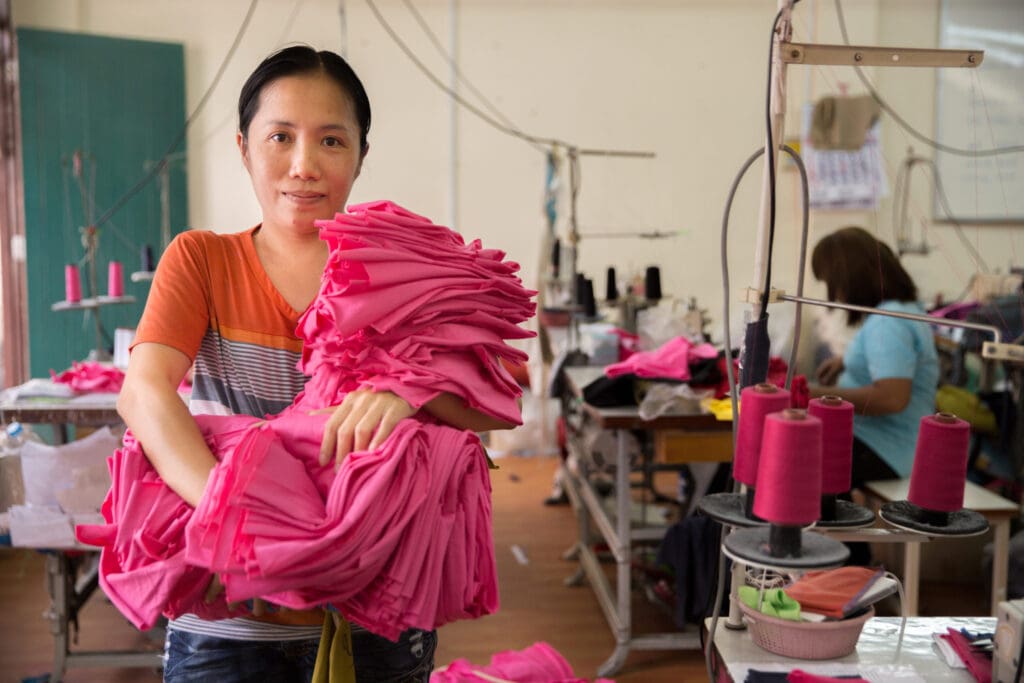Gender Equity in Textile, Clothing, and Footwear Manufacturing Resource Hub
These textile, clothing, and footwear manufacturing sector tools can be used by manufacturers to identify opportunities for enhancing gender integration, assess the current extent of gender integration across policies, practices, and operations, and advise suppliers and facilities on how to better integrate gender through their operations and supply chain.
Gender Opportunities Explorer
Gender Self-Diagnostic Tool
Case Studies
 For sustainable production, manufacturing suppliers need to think about how to enhance gender equity within their facilities and create an enabling work environment for female employees.
For sustainable production, manufacturing suppliers need to think about how to enhance gender equity within their facilities and create an enabling work environment for female employees.
This Resource Hub can help you learn how to better integrate gender within manufacturing facilities to enhance business success, employee well-being, gender equity, and women’s economic empowerment.
The Self-Diagnostic Tool is designed to diagnose current strengths and areas for improvement to integrate gender into policies procedures, and operations. The Opportunities Explorer provides recommended opportunities to most effectively integrate gender into policies, procedures, and operations. The Case Studies provide examples of companies that have integrated gender into their operations and the resulting impacts.
-
Why integrate gender into manufacturing operations?
For companies, improving working conditions and opportunities for women (and all employees) is an investment, not a cost. In a sector comprised of a predominately female labor force, manufacturers that invest in gender equity provide valuable opportunities for their employees and gain an important competitive advantage. Making it both the right thing to do and the smart thing to do. Time and time again, research links improved working conditions and gender equity in factories with increased productivity and outputs alongside reductions in absenteeism, turnover, and production errors. When companies invest in creating an enabling work environment for their employees, they are able to more easily attract, retain, and promote top talent. This enables them to save on costs associated with recruitment and training as they are able to promote from within. It also helps to ensure diversity in leadership and management teams – in particular gender diversity – which leads to more diverse perspectives integrated into decision-making and management.
A crucial element of investing in gender equity in factories is the prevention and mitigation of sexual harassment. There are key policies, procedures, and organizational shifts that can enable factories to effectively respond to incidents of sexual harassment and also prevent sexual harassment from happening. Broader investments in gender equity can both enhance this response and help to create an environment where sexual harassment doesn’t happen in the first place.
For women, formal employment in a decent, safe, and empowering workplace remains critical for their livelihoods and economic well-being. Workforce development programs implemented by brands, suppliers, international organizations, and multilaterals have demonstrated impacts in women’s agency, self-efficacy, financial literacy, health practices, and soft skills – impacting not only their well-being, but also, by extension, that of their families and communities. Furthermore, as women are supported with policies and procedures that create an enabling work environment, they are motivated to stay and rise within factories, enhancing their own economic stability. Inclusion and acceptance allow all employees to thrive while driving business success. When the most vulnerable groups in the supply chain are supported, including women, equal opportunities are promoted for all.
For more, see the Overview page.
-
What is gender equality vs gender equity?
Gender equality = the same treatment of all people regardless of gender identity. Equality in provision of support/services to all people fails to recognize the ways that gender identity informs one’s aspirations, and access to resources and opportunities.
Gender equity = taking into consideration the diversity of all people across all genders and identities and providing support and services in response to their gender. In this way, gender equitable provision of support/services is needed in order to achieve gender equality.
Due to social norms, patriarchal power structures, and historic practices, women and girls often start from a position of disempowerment and societal constraint. Therefore, gender equitable policies, practices, and operations may be needed in order to balance the playing field and give them access to opportunities and benefits – ultimately resulting in gender equality as the end goal.
-
How do these resources enable me to better integrate gender?
As the desire to move beyond compliance evolves and grows, so must the instruments for assessments and learning. This Resource Hub builds on a foundation of sector-specific research and diagnostic processes to meet a need that goes beyond traditional audit and compliance measures: gender-focused tools for supplier-driven learning and decision-making.
The open source tools on this Hub help manufacturing suppliers locate opportunities and actions to improve gender equity within their facilities, thereby powering worker well-being and business innovation. Explore the following resources:
- A Overview on the state of gender in the sector.
- A Gender Opportunities Explorer that allows users to learn more about ways to better integrate gender in group-level and facility operations. Opportunities are categorized as foundational or advanced.
- A Self-Diagnostic Tool & Scorecard for diagnosing strengths and areas for improvement for integrating gender across factory policies, practices, and operations and generating a customized scorecard. The tool can be used to generate a snapshot of performance related to gender equity, compare the extent of gender integration across facilities, identify new gender opportunities with high likelihood of impact, and help inform priority areas for action.
- Case Studies to illustrate examples of how leading manufacturers have integrated gender into their operations, and the resulting business and social benefits.
-
How was this Hub developed?
The Gender Equity TCF Manufacturing Resource Hub was developed by ICRW Advisors in 2020 with funding from Nike Inc. This tool is used by Nike’s strategic suppliers to help inform and improve their understanding of gender equity within their own organizations.

